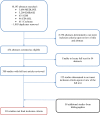Delays and Barriers to Cancer Care in Low- and Middle-Income Countries: A Systematic Review
- PMID: 31387949
- PMCID: PMC6975966
- DOI: 10.1634/theoncologist.2019-0057
Delays and Barriers to Cancer Care in Low- and Middle-Income Countries: A Systematic Review
Abstract
Background: Advanced stage presentation of patients with is common in low- and middle-income countries (LMICs). A comprehensive analysis of existing delays and barriers in LMICs has not been previously reported. We conducted a systematic literature review to comprehensively outline delays and barriers to identify targets for future interventions and provide recommendations for future research in this field.
Materials and methods: Multiple electronic databases were searched using a standardized search strategy. Eligible articles were of any language, from LMICs, and published between January 1, 2002, and November 27, 2017. Included studies reported cancer care intervals or barriers encountered. Intervals and associated barriers were summarized by cancer type and geographical region.
Results: This review included 316 study populations from 57 LMICs: 142 (44.9%) studies addressed time intervals, whereas 214 (67.7%) studies described barriers to cancer diagnosis. The median intervals were similar in the following three stages of early diagnosis: (a) access (1.2 months), (b) diagnostic (0.9 months), and (c) treatment (0.8 months). Studies from low-income countries had significantly longer access intervals (median, 6.5 months) compared with other country income groups. Patients with breast cancer had longer delay intervals than patients with childhood cancer. No significant variation existed between geographic regions. Low health literacy was reported most frequently in studies describing barriers to cancer diagnosis and was associated with lower education level, no formal employment, lower income, and rural residence.
Conclusion: Early diagnosis strategies should address barriers during all three intervals contributing to late presentation in LMICs. Standardization in studying and reporting delay intervals in LMICs is needed to monitor progress and facilitate comparisons across settings.
Implications for practice: This review draws the attention of cancer implementation scientists globally. The findings highlight the significant delays that occur throughout the cancer care continuum in low- and middle-income countries and describe common barriers that cause them. This review will help shape the global research agenda by proposing metrics and implementation studies. By demonstrating the importance of standardized reporting metrics, this report sets forth additional research and evidence needed to inform cancer control policies.
摘要
背景。在中低收入国家 (LMIC),晚期患者十分常见。以前,人们从未报告有关LMIC癌症治疗延误和障碍现状的综合分析。我们开展了一项系统的文献回顾工作,旨在全面地列述各种延误和障碍,以确定未来干预措施的目标并为该领域中的未来研究提供建议。
材料和方法。采用标准化检索策略在多个电子数据库中进行检索。符合条件的文章为在 2002 年 1 月 1 日至 2017 年 11 月 27 日期间以任何语言在LMIC发表的文章。纳入的研究报告了癌症治疗的时间间隔或遇到的障碍。按照癌症类型和地理区域,我们对时间间隔和相关的障碍进行了总结。
结果。本次回顾工作包含来自 57 个LMIC的 316 项研究人群:142 (44.9%) 项研究提到了时间间隔,而 214 (67.7%) 项研究描述了癌症诊断的障碍。在早期诊断的以下三个阶段中,中位时间间隔相似:(a) 就诊(1.2 个月),(b) 诊断(0.9 个月)以及 (c) 治疗(0.8 个月)。与其他国家收入群体相比,低收入国家的就诊时间间隔明显更长(中位6.5 个月)。与儿童期癌症患者相比,乳腺癌患者的延误时间间隔更长。地理区域之间没有显著差异。在描述癌症诊断障碍的研究中,最常报告的是健康素养低,这一障碍与教育水平较低、无正式职业、收入较低以及在农村居住相关。
结论。早期诊断策略应该解决所有三个时间间隔中延误LMIC患者的诊断和治疗的障碍。对于LMIC的延误时间间隔,人们需要实现研究和报告的标准化,以监控进展情况并促进各种环境之间的对比。
实践意义:本次回顾工作引起了全球癌症一线科学家的关注。研究结果重点指出了在中低收入国家癌症连续治疗期间发生的重大延误问题并描述了导致此类问题的常见障碍。通过提出指标和实践研究,本次回顾工作将帮助制定全球研究议程。通过证实标准化报告指标的重要性,本报告提出了传达癌症控制政策所需的其他研究和证据。
Keywords: Cancer; Delay interval; Early diagnosis; Low‐ and middle‐income country.
© 2019 The Authors. The Oncologist published by Wiley Periodicals, Inc. on behalf of AlphaMed Press.
Conflict of interest statement
Disclosures of potential conflicts of interest may be found at the end of this article.
Figures


References
-
- Bray F, Ferlay J, Soerjomataram I et al. Global cancer statistics 2018: GLOBOCAN estimates of incidence and mortality worldwide for 36 cancers in 185 countries. CA Cancer J Clin 2018;68:394–424. - PubMed
-
- Richards MA, Westcombe AM, Love SB et al. Influence of delay on survival in patients with breast cancer: A systematic review. Lancet 1999;353:1119–1126. - PubMed
-
- World Health Organization . Guide To Cancer Early Diagnosis. Geneva, Switzerland: World Health Organization, 2017. Available from: http://apps.who.int/iris/bitstream/10665/254500/1/9789241511940‐eng.pdf?.... Accessed January 10, 2017.

